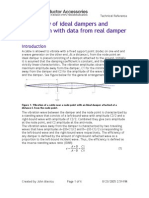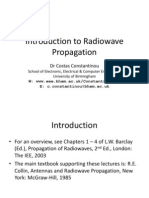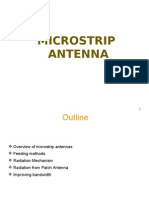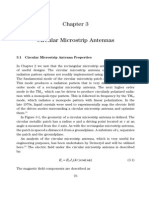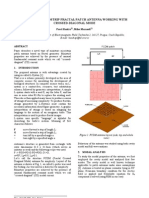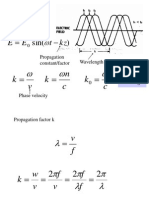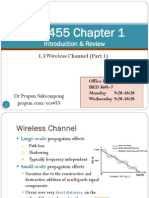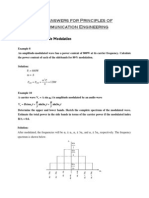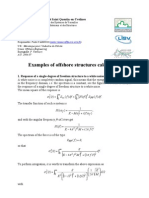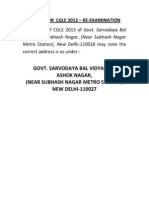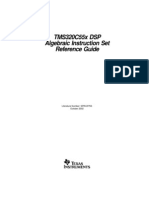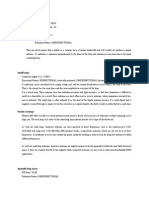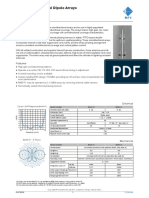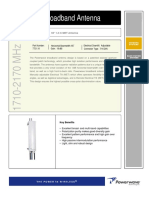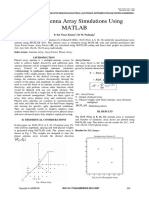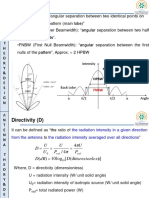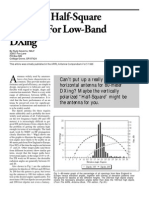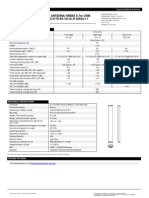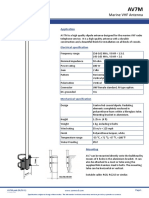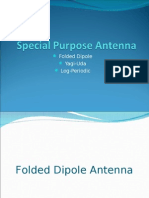5 Microstrip Antennas
5 Microstrip Antennas
Uploaded by
yashgl23Copyright:
Available Formats
5 Microstrip Antennas
5 Microstrip Antennas
Uploaded by
yashgl23Original Description:
Copyright
Available Formats
Share this document
Did you find this document useful?
Is this content inappropriate?
Copyright:
Available Formats
5 Microstrip Antennas
5 Microstrip Antennas
Uploaded by
yashgl23Copyright:
Available Formats
Overview of Microstrip Antennas
Also called patch antennas
One of the most useful antennas at microwave frequencies
(f > 1 GHz).
It consists of a metal patch on top of a grounded
dielectric substrate.
The patch may be in a variety of shapes, but rectangular
and circular are the most common.
2
History of Microstrip Antennas
Invented by Bob Munson in 1972 (but earlier work
by Dechamps goes back to1953).
Became popular starting in the 1970s.
G. Deschamps and W. Sichak, Microstrip Microwave Antennas, Proc. of
Third Symp. on USAF Antenna Research and Development Program,
October 1822, 1953.
R. E. Munson, Microstrip Phased Array Antennas, Proc. of Twenty-
Second Symp. on USAF Antenna Research and Development Program,
October 1972.
R. E. Munson, Conformal Microstrip Antennas and Microstrip Phased
Arrays, IEEE Trans. Antennas Propagat., vol. AP-22, no. 1 (January
1974): 7478.
3
Typical Applications
Single element
Array
(Photos courtesy of Dr. Rodney B. Waterhouse)
4
Typical Applications (cont.)
Microstrip Antenna Integrated into a System: HIC Antenna Base-Station for 28-43 GHz
filter
MPA
diplexer
LNA
PD
K-connector
DC supply
Micro-D
connector
microstrip
antenna
fiber input with
collimating lens
(Photo courtesy of Dr. Rodney B. Waterhouse) 5
Geometry of Rectangular Patch
x
y
h
L
W
Note: L is the resonant dimension. The width W is usually
chosen to be larger than L (to get higher bandwidth).
However, usually W < 2L. W = 1.5L is typical.
c
r
6
Geometry of Rectangular Patch (cont.)
View showing coaxial feed
x
y
L
W
feed at (x
0
, y
0
)
A feed along the
centerline is the most
common (minimizes
higher-order modes
and cross-pol.)
x
surface current
7
Advantages of Microstrip Antennas
Low profile (can even be conformal).
Easy to fabricate (use etching and phototlithography).
Easy to feed (coaxial cable, microstrip line, etc.) .
Easy to use in an array or incorporate with other
microstrip circuit elements.
Patterns are somewhat hemispherical, with a moderate
directivity (about 6-8 dB is typical).
8
Disadvantages of Microstrip Antennas
Low bandwidth (but can be improved by a variety of
techniques). Bandwidths of a few percent are typical.
Bandwidth is roughly proportional to the substrate
thickness.
Efficiency may be lower than with other antennas.
Efficiency is limited by conductor and dielectric
losses*, and by surface-wave loss**.
* Conductor and dielectric losses become more
severe for thinner substrates.
** Surface-wave losses become more severe for
thicker substrates (unless air or foam is used).
9
Basic Principles of Operation
The patch acts approximately as a resonant cavity (short
circuit (PEC) walls on top and bottom, open-circuit (PMC)
walls on the sides).
In a cavity, only certain modes are allowed to exist, at
different resonant frequencies.
If the antenna is excited at a resonance frequency, a strong
field is set up inside the cavity, and a strong current on the
(bottom) surface of the patch. This produces significant
radiation (a good antenna).
Note: As the substrate thickness gets smaller the patch current radiates less,
due to image cancellation. However, the Q of the resonant mode also
increases, making the patch currents stronger at resonance. These two effects
cancel, allowing the patch to radiate well even for small substrate thicknesses.
10
Thin Substrate Approximation
On patch and ground plane, 0
t
E =
( )
,
z
E z E x y =
Inside the patch cavity, because of the thin substrate, the
electric field vector is approximately independent of z.
Hence
( )
,
z
E z E x y ~
h
( )
,
z
E x y
11
Thin Substrate Approximation
( ) ( )
( ) ( )
1
1
,
1
,
z
z
H E
j
zE x y
j
z E x y
j
e
e
e
= V
= V
= V
Magnetic field inside patch cavity:
12
Thin Substrate Approximation (cont.)
( ) ( ) ( )
1
, ,
z
H x y z E x y
je
= V
Note: The magnetic field is purely horizontal.
(The mode is TM
z
.)
h
( )
,
z
E x y
( )
, H x y
13
Magnetic Wall Approximation
On edges of patch,
0
s
J n =
( )
0
bot
s
J z H = ~
Hence,
0
t
H =
x
y
n L
W
s
J
t
Also, on bottom surface of
patch conductor we have
n
H n H =
n
h
H
(J
s
is the sum of the top and bottom surface currents.)
14
Magnetic Wall Approximation (cont.)
n
h
0 ( )
t
H = PMC
Since the magnetic field is approximately
independent of z, we have an approximate
PMC condition on the entire vertical edge.
PMC
x
y
n L
W
s
J
t
15
n
h
x
y
n
L
W
t
Hence,
PMC
0
z
E
n
c
=
c
( ) ( ) ( )
1
, ,
z
H x y z E x y
je
= V
( )
, 0 n H x y =
( ) ( )
, 0
z
n z E x y V =
( ) ( )
, 0
z
z n E x y V =
Magnetic Wall Approximation (cont.)
( ) ( ) ( ) ( ) ( )( )
, , ,
z z z
n z E x y z n E x y E x y n z V = V V
16
Resonance Frequencies
2 2
0
z z
E k E V + =
cos cos
z
m x n y
E
L W
t t
| | | |
=
| |
\ . \ .
2 2
2
0
z
m n
k E
L W
t t
(
| | | |
+ =
(
| |
\ . \ .
(
Hence
2 2
2
0
m n
k
L W
t t
(
| | | |
+ =
(
| |
\ . \ .
(
x
y
L
W
From separation of variables:
(TM
mn
mode)
PMC
( )
,
z
E x y
17
Resonance Frequencies (cont.)
2 2
2
m n
k
L W
t t
| | | |
= +
| |
\ . \ .
0 0 r
k e c c =
Recall that
2 f e t =
Hence
2 2
2
r
c m n
f
L W
t t
t c
| | | |
= +
| |
\ . \ .
0 0
1/ c c =
x
y
L
W
18
2 2
2
mn
r
c m n
f
L W
t t
t c
| | | |
= +
| |
\ . \ .
Hence
mn
f f =
(resonance frequency of
(m, n) mode)
Resonance Frequencies (cont.)
x
y
L
W
19
(1,0) Mode
This mode is usually used because the
radiation pattern has a broadside beam.
10
1
2
r
c
f
L
c
| |
=
|
\ .
cos
z
x
E
L
t
| |
=
|
\ .
0
1
sin
s
x
J x
j L L
t t
e
| |
| | | |
=
|
| |
\ . \ .
\ .
This mode acts as a wide
microstrip line (width W)
that has a resonant length
of 0.5 guided wavelengths
in the x direction.
x
y
L
W
current
20
Basic Properties of Microstrip Antennas
The resonance frequency is controlled by the patch
length L and the substrate permittivity.
Resonance Frequency
Note: A higher substrate permittivity allows for a smaller
antenna (miniaturization) but lower bandwidth.
Approximately, (assuming PMC walls)
Note: This is equivalent to
saying that the length L is
one-half of a wavelength in
the dielectric:
0
/ 2
/ 2
d
r
L
c
= = kL t =
2 2
2
m n
k
L W
t t
| | | |
= +
| |
\ . \ .
(1,0) mode:
21
The calculation can be improved by adding a
fringing length extension AL to each edge of the
patch to get an effective length L
e
.
Resonance Frequency (cont.)
10
1
2
e
r
c
f
L
c
| |
=
|
\ .
2
e
L L L = + A
y
x
L
L
e
AL AL
Note: Some authors use effective permittivity in this equation.
22
Resonance Frequency (cont.)
Hammerstad formula:
( )
( )
0.3 0.264
/ 0.412
0.258 0.8
eff
r
eff
r
W
h
L h
W
h
c
c
(
| |
+ +
|
(
\ .
(
A =
| |
(
+
|
(
\ .
1/ 2
1 1
1 12
2 2
eff
r r
r
h
W
c c
c
( +
| | | |
= + +
| |
(
\ . \ .
23
Resonance Frequency (cont.)
Note: 0.5 L h A ~
This is a good rule of thumb.
24
0 0.01 0.02 0.03 0.04 0.05 0.06 0.07
h /
0
0.75
0.8
0.85
0.9
0.95
1
N
O
R
M
A
L
I
Z
E
D
F
R
E
Q
U
E
N
C
Y
Hammerstad
Measured
W/ L = 1.5
c
r
= 2.2
The resonance frequency has been normalized
by the zero-order value (without fringing):
f
N
= f / f
0
Results: Resonance frequency
25
Basic Properties of Microstrip Antennas
The bandwidth is directly proportional to substrate
thickness h.
However, if h is greater than about 0.05
0
, the probe
inductance (for a coaxial feed) becomes large enough so
that matching is difficult.
The bandwidth is inversely proportional to c
r
(a foam
substrate gives a high bandwidth).
Bandwidth: Substrate effects
26
Basic Properties of Microstrip Antennas
The bandwidth is directly proportional to the width W.
Bandwidth: Patch geometry
Normally W < 2L because of geometry constraints
and to avoid (0, 2) mode:
W = 1.5 L is typical.
27
Basic Properties of Microstrip Antennas
Bandwidth: Typical results
For a typical substrate thickness (h /
0
= 0.02), and a
typical substrate permittivity (c
r
= 2.2) the bandwidth is
about 3%.
By using a thick foam substrate, bandwidth of about
10% can be achieved.
By using special feeding techniques (aperture coupling)
and stacked patches, bandwidths of 100% have been
achieved.
28
0 0.01 0.02 0.03 0.04 0.05 0.06 0.07 0.08 0.09 0.1
h /
0
0
5
10
15
20
25
30
B
A
N
D
W
I
D
T
H
(
%
)c
r
2.2
= 10.8
W/ L = 1.5 c
r
= 2.2 or 10.8
Results: Bandwidth
The discrete data points are measured values. The solid curves are
from a CAD formula.
29
Basic Properties of Microstrip Antennas
The resonant input resistance is almost independent
of the substrate thickness h (the variation is mainly
due to dielectric and conductor loss)
The resonant input resistance is proportional to c
r.
The resonant input resistance is directly controlled by
the location of the feed point. (maximum at edges x =
0 or x = L, zero at center of patch.
Resonant Input Resistance
L
W
(x
0
, y
0
)
L
x
y
30
Resonant Input Resistance (cont.)
Note: The patch is usually fed along the centerline (y
0
= W / 2)
to maintain symmetry and thus minimize excitation of
undesirable modes (which cause cross-pol).
Desired mode: (1,0)
L
x
W
feed: (x
0
, y
0
)
y
31
Resonant Input Resistance (cont.)
For a given mode, it can be shown that the resonant input
resistance is proportional to the square of the cavity-mode
field at the feed point.
( )
2
0 0
,
in z
R E x y
For (1,0) mode:
2
0
cos
in
x
R
L
t
| |
|
\ .
L
x
W
(x
0
, y
0
)
y
32
Resonant Input Resistance (cont.)
Hence, for (1,0) mode:
2
0
cos
in edge
x
R R
L
t
| |
=
|
\ .
The value of R
edge
depends strongly on the substrate permittivity. For
a typical patch, it may be about 100-200 Ohms.
L
x
W
(x
0
, y
0
)
y
33
0 0.01 0.02 0.03 0.04 0.05 0.06 0.07 0.08
h /
0
0
50
100
150
200
I
N
P
U
T
R
E
S
I
S
T
A
N
C
E
(
O
)
2.2
r
= 10.8
c
c
r
= 2.2 or 10.8
W/L = 1.5
x
0
= L/4
Results: Resonant input resistance
The discrete
data points are
from a CAD
formula.
L
x
W
(x
0
, y
0
)
y
y
0
= W/2
34
Basic Properties of Microstrip Antennas
Radiation Efficiency
The radiation efficiency is less than 100% due to
conductor loss
dielectric loss
surface-wave power
Radiation efficiency is the ratio of power radiated
into space, to the total input power.
r
r
tot
P
e
P
=
35
Radiation Efficiency (cont.)
surface wave
TM
0
cos (|) pattern
x
y
36
Radiation Efficiency (cont.)
( )
r r
r
tot r c d sw
P P
e
P P P P P
= =
+ + +
P
r
= radiated power
P
tot
= total input power
P
c
= power dissipated by conductors
P
d
= power dissipated by dielectric
P
sw
= power launched into surface wave
Hence,
37
Radiation Efficiency (cont.)
Conductor and dielectric loss is more important for
thinner substrates.
Conductor loss increases with frequency (proportional
to f
) due to the skin effect. Conductor loss is usually
more important than dielectric loss.
2
o
eo
=
1
s
R
oo
=
R
s
is the surface resistance
of the metal. The skin depth
of the metal is o.
38
Radiation Efficiency (cont.)
Surface-wave power is more important for thicker substrates
or for higher substrate permittivities. (The surface-wave
power can be minimized by using a foam substrate.)
39
Radiation Efficiency (cont.)
For a foam substrate, higher radiation efficiency is
obtained by making the substrate thicker (minimizing the
conductor and dielectric losses). The thicker the better!
For a typical substrate such as c
r
= 2.2, the radiation
efficiency is maximum for h /
0
~ 0.02.
40
c
r
= 2.2 or 10.8 W/L = 1.5
0 0.01 0.02 0.03 0.04 0.05 0.06 0.07 0.08 0.09 0.1
h /
0
0
20
40
60
80
100
E
F
F
I
C
I
E
N
C
Y
(
%
)
exact
CAD
Results: Conductor and dielectric losses are neglected
2.2
10.8
Note: CAD plot uses Pozar formulas
41
0 0.02 0.04 0.06 0.08 0.1
h /
0
0
20
40
60
80
100
E
F
F
I
C
I
E
N
C
Y
(
%
)
c = 10.8
2.2
exact
CAD
r
c
r
= 2.2 or 10.8
W/L = 1.5
Results: Accounting for all losses
Note: CAD plot uses Pozar formulas
42
Basic Properties of Microstrip Antenna
Radiation Patterns
The E-plane pattern is typically broader than the H-
plane pattern.
The truncation of the ground plane will cause edge
diffraction, which tends to degrade the pattern by
introducing:
rippling in the forward direction
back-radiation
Note: Pattern distortion is more severe in
the E-plane, due to the angle dependence
of the vertical polarization E
u
and the SW
pattern. Both vary as cos (|).
43
Radiation Patterns (cont.)
-90
-60
-30
0
30
60
90
120
150
180
210
240
-40
-30
-30
-20
-20
-10
-10
E-plane pattern
Red: infinite substrate and ground plane
Blue: 1 meter ground plane
Note: The E-plane
pattern tucks in and
tends to zero at the
horizon due to the
presence of the infinite
substrate.
44
H-plane pattern
Red: infinite substrate and ground plane
Blue: 1 meter ground plane
-90
-45
0
45
90
135
180
225
-40
-30
-30
-20
-20
-10
-10
Radiation Patterns (cont.)
45
Basic Properties of Microstrip Antennas
Directivity
The directivity is fairly insensitive to the substrate
thickness.
The directivity is higher for lower permittivity, because
the patch is larger.
46
0 0.01 0.02 0.03 0.04 0.05 0.06 0.07 0.08 0.09 0.1
h /
0
0
2
4
6
8
10
D
I
R
E
C
T
I
V
I
T
Y
(
d
B
)
exact
CAD
= 2.2
10.8
c
r
c
r
= 2.2 or 10.8 W/ L = 1.5
Results: Directivity
47
Approximate CAD Model for Z
in
Near the resonance frequency, the patch cavity can be
approximately modeled as an RLC circuit.
A probe inductance L
p
is added in series, to account for the
probe inductance of a probe feed.
L
p
R
C
L
Z
in
probe patch cavity
48
Approximate CAD Model (cont.)
L
p
R
C
L
( )
0
1 2 / 1
in p
R
Z j L
j Q f f
e ~ +
+
0
R
Q
L e
=
1
2
BW
Q
=
BWis defined here by
SWR < 2.0.
0 0
1
2 f
LC
e t = =
49
Approximate CAD Model (cont.)
in max
R R =
R
in max
is the input resistance at the resonance of the
patch cavity (the frequency that maximizes R
in
).
L
p
R
C
L
50
4 4.5 5 5.5 6
FREQUENCY (GHz)
0
10
20
30
40
50
60
70
80
R
i
n
(
O
)
CAD
exact
Results : Input resistance vs. frequency
c
r
= 2.2 W/L = 1.5 L = 3.0 cm
frequency where the
input resistance is
maximum (f
0
)
51
Results: Input reactance vs. frequency
c
r
= 2.2
W/L = 1.5
4 4.5 5 5.5 6
FREQUENCY (GHz)
-40
-20
0
20
40
60
80
X
i
n
(
O
)
CAD
exact
L = 3.0 cm
frequency where the input
resistance is maximum (f
0
)
frequency where the
input impedance is real
shift due to probe reactance
52
Approximate CAD Model (cont.)
0.577216
( )
( )
0
0
0
2
ln
2
f
r
X k h
k a
q
t
c
(
| |
= + (
|
|
(
\ .
(Eulers constant)
Approximate CAD formula for feed (probe) reactance (in Ohms)
f p
X L e =
0 0 0
/ 376.73 q c = = O
a = probe radius h = probe height
This is based on an infinite parallel-plate model.
53
Approximate CAD Model (cont.)
( )
( )
0
0
0
2
ln
2
f
r
X k h
k a
q
t
c
(
| |
= + (
|
|
(
\ .
Feed (probe) reactance increases proportionally with
substrate thickness h.
Feed reactance increases for smaller probe radius.
54
0 0.1 0.2 0.3 0.4 0.5 0.6 0.7 0.8 0.9 1
X
r
0
5
10
15
20
25
30
35
40
X
f
(
O
)
CAD
exact
Results: Probe reactance (X
f
=X
p
= eL
p
)
x
r
= 2 ( x
0
/ L) - 1
x
r
is zero at the center of the patch, and is
1.0 at the patch edge.
c
r
= 2.2
W/L = 1.5
h = 0.0254
0
a = 0.5 mm
55
CAD Formulas
In the following viewgraphs, CAD formulas for the
important properties of the rectangular microstrip
antenna will be shown.
56
CAD Formula: Radiation Efficiency
0 0 1 0
1 3 1
1
/ 16 /
hed
r
r
hed
s r
r d
e
e
R L
e
h pc W h
c
tq
=
( (
| || | | | | |
| | | |
+ +
( ( | | | | | |
\ . \ .
\ . \ .\ . \ .
where
tan
d
o = =loss tangent of substrate
1
2
s
R
e
oo o
= = = surface resistance of metal
57
CAD Formula: Radiation Efficiency (cont.)
where
Note: hed refers to a unit-amplitude horizontal electric dipole.
( )
( )
2
2
0 1
2
0
1
80
hed
sp
P k h c t
=
1
1
hed
sp
hed
r
hed hed hed
sw sp sw
hed
sp
P
e
P P P
P
= =
+
+
( )
3
3
3
0 1
2
0
1 1
60 1
hed
sw
r
P k h c t
c
(
| |
( =
|
(
\ .
58
CAD Formula: Radiation Efficiency (cont.)
( )
3
0
1
1
3 1 1
1 1
4
hed
r
r
e
k h
c
t
c
=
| || |
+
| |
\ .\ .
Hence we have
(Physically, this term is the radiation efficiency of a
horizontal electric dipole (hed) on top of the substrate.)
59
1
2
1 2/ 5
1
r r
c
c c
= +
( )
( )
( ) ( )
( ) ( )
2 4 2
2
2
0 2 4 0 2 0
2 2
2 2 0 0
3 1
1 2
10 560 5
1
70
a
p k W a a k W c k L
a c k W k L
| | | |
= + + + +
| |
\ . \ .
| |
+
|
\ .
The constants are defined as
2
0.16605 a =
4
0.00761 a =
2
0.0914153 c =
CAD Formula: Radiation Efficiency (cont.)
60
CAD Formula: Radiation Efficiency (cont.)
1
1
hed
r
hed
sw
hed
sp
e
P
P
=
+
Improved formula (due to Pozar)
( )
( )
( )
3/ 2
2
2
0
0 0
2 2
1 0 0 1
1
4
1 ( ) 1 1
r
hed
sw
r r
x
k
P
x k h x x
c
q
c c
=
+ + +
2
0
1
2
0
1
r
x
x
x c
=
2 2 2
0 1 0 1 0
0
2 2
1
2
1
r r r
r
x
c o o c c o o o
c o
+ + +
= +
( )
( )
2
2
0 1
2
0
1
80
hed
sp
P k h c t
=
61
CAD Formula: Radiation Efficiency (cont.)
Improved formula (cont.)
( )
0 0
tan s k h s o ( =
( )
( )
( )
0
1 0
2
0
1
tan
cos
k h s
k h s
s k h s
o
(
( = +
(
(
(
1
r
s c =
62
CAD Formula: Bandwidth
1
0 0 0
1 1 16 1
/ 3
2
s
d
hed
r r
R pc h W
BW
h L e tq c
(
| |
| | | | | | | |
| | | |
= + + ( |
| | | |
| |
|
\ . \ .
( \ . \ . \ . \ .
\ .
BW is defined from the frequency limits f
1
and f
2
at which
SWR = 2.0.
2 1
0
f f
BW
f
=
(multiply by 100 if you want to get %)
63
CAD Formula: Resonant Input Resistance
2
0
cos
edge
x
R R
L
t
| |
=
|
\ .
(probe-feed)
( )
0
0
1
0 0 0
4
1 16 1
/ 3
edge
s
d
hed
r r
L h
W
R
R pc W h
h L e
q
t
tq c
| |
| | | |
| | |
\ . \ .
\ .
=
| || | | | | | | |
| | | |
+ +
| | | | | | |
\ . \ .
\ . \ . \ .\ . \ .
64
CAD Formula: Directivity
( ) ( )
tanc tan / x x x
where
( )
( )
( )
2
1
2
1 1
3
tanc
tan
r
r
D k h
pc k h
c
c
(
| |
=
(
|
+
\ .
65
CAD Formula: Directivity (cont.)
1
3
D
pc
~
For thin substrates:
(The directivity is essentially independent of the
substrate thickness.)
66
CAD Formula: Radiation Patterns
(based on electric current model)
The origin is at the
center of the patch.
L
r
h
infinite GP and substrate
x
The probe is on the x axis.
cos
s
x
J x
L
y
L
W
E-plane
H-plane
x
(1,0) mode
67
CAD Formula: Radiation Patterns (cont.)
( )
2 2
sin
cos
2
2
( , , ) , ,
2
2
2 2
y
x
hex
i i
y
x
k W
k L
WL
E r E r
k W
k L
t
u | u |
t
( ( | |
| |
( ( |
|
| |
\ . \ .
( (
=
|
( (
\ .
| | | |
( (
| |
\ . \ .
0
sin cos
x
k k u | =
0
sin sin
y
k k u | =
The hex pattern is for a horizontal electric dipole in the x direction,
sitting on top of the substrate.
or i u | =
The far-field pattern can be determined by reciprocity.
68
( ) ( )
0
, , cos
hex
E r E G
u
u | | u =
( ) ( )
0
, , sin
hex
E r E F
|
u | | u =
where
( ) ( )
( ) ( )
( ) ( ) ( )
0
0
2tan
1
tan sec
TE
k h N
F
k h N j N
u
u u
u u u
= +I =
( ) ( ) ( )
( ) ( )
( ) ( )
( )
0
0
2tan cos
cos 1
tan cos
TM
r
k h N
G
k h N j
N
u u
u u u
c
u u
u
= +I =
( ) ( )
2
sin
r
N u c u =
0
0
0
4
jk r
j
E e
r
e
t
| |
=
|
\ .
CAD Formula: Radiation Patterns (cont.)
69
Circular Polarization
Three main techniques:
1) Single feed with nearly degenerate eigenmodes (compact
but narrow CP bandwidth).
2) Dual feed with delay line or 90
o
hybrid phase shifter
(broader CP bandwidth but uses more space).
3) Synchronous subarray technique (produces high-quality CP due
to cancellation effect, but requires more space).
70
Circular Polarization: Single Feed
L
W
Basic principle: the two modes are excited with equal
amplitude, but with a 45
o
phase.
The feed is on the diagonal.
The patch is nearly (but not
exactly) square.
L W ~
71
Circular Polarization: Single Feed
Design equations:
0 CP
f f =
0
1
1
2
x
f f
Q
| |
=
|
\ .
0
1
1
2
y
f f
Q
| |
=
|
\ .
Top sign for LHCP,
bottom sign for RHCP.
in x y
R R R = =
R
x
and R
y
are the resonant input resistances of the two LP (x and y)
modes, for the same feed position as in the CP patch.
L
W
x
y
1
2
BW
Q
=
(SWR < 2 )
The resonance frequency
(R
in
is maximum) is the
optimum CP frequency.
)
0 0
x y =
At resonance:
72
Circular Polarization: Single Feed (cont.)
Other Variations
Patch with slot Patch with truncated corners
Note: Diagonal modes are used as degenerate modes
L
L
x
y
L
L
x
y
73
Circular Polarization: Dual Feed
L
L
x
y
P
P+
g
/4
RHCP
Phase shift realized with delay line
74
Circular Polarization: Dual Feed
Phase shift realized with 90
o
hybrid (branchline coupler)
g
/4
LHCP
g
/4
0
Z 0
/ 2 Z
feed
50 Ohm load
0
Z
0
Z
75
Circular Polarization: Synchronous Rotation
Elements are rotated in space and fed with phase shifts
0
o
-90
o
-180
o
-270
o
Because of symmetry, radiation from higher-order modes (or probes)
tends to be reduced, resulting in good cross-pol.
76
Circular Patch
x
y
h
a
c
r
77
Circular Patch: Resonance Frequency
a
PMC
From separation of variables:
( ) ( )
cos
z m
E m J k | =
J
m
= Bessel function of first kind, order m.
0
z
a
E
=
c
=
c
( )
0
m
J ka
'
=
78
Circular Patch: Resonance Frequency (cont.)
mn
ka x
'
=
a
PMC
(nth root of J
m
'
Bessel function)
2
mn mn
r
c
f x
t c
'
=
Dominant mode: TM
11
11 11
2
r
c
f x
a t c
'
=
11
1.842 x
'
~
79
Fringing extension: a
e
= a + Aa
11 11
2
e r
c
f x
a t c
'
=
Long/Shen Formula:
a
PMC
a + Aa
ln 1.7726
2
r
h a
a
h
t
tc
(
| |
A ~ +
| (
\ .
2
1 ln 1.7726
2
e
r
h a
a a
a h
t
t c
(
| |
= + +
| (
\ .
or
Circular Patch: Resonance Frequency (cont.)
80
Circular Patch: Patterns
(based on magnetic current model)
( )
( )
( )
1
1
1
, cos
z
J k
E
J ka h
| |
| |
| |
=
|
|
|
\ .
\ .
(The edge voltage has a maximum of one volt.)
a
y
x
E-plane
H-plane
In patch cavity:
The probe is on the x axis.
2a
r
h
infinite GP and substrate
0 r
k k
x
The origin is at the
center of the patch.
81
Circular Patch: Patterns (cont.)
( ) ( ) ( ) ( )
0
1 1 0
0
, , 2 tanc cos sin
R
z
E
E r a k h J k a Q
u
u | t | u u
q
'
=
( ) ( )
( )
( )
1 0
0
1
0 0
sin
, , 2 tanc sin
sin
R
z
J k a
E
E r a k h P
k a
u
u | t | u
q u
| |
=
|
\ .
( ) ( ) ( )
( )
( ) ( ) ( )
0
2
cos 1 cos
tan sec
TE
jN
P
k hN jN
u
u u u u
u u u
(
= I =
(
(
( ) ( )
( )
( ) ( )
( )
0
2 cos
1
tan cos
r
TM
r
j
N
Q
k h N j
N
c
u
u
u u
c
u u
u
| |
|
\ .
= I =
tanc tan x x / x
where
( ) ( )
2
sin
r
N u c u = 82
Circular Patch: Input Resistance
( )
( )
2
1 0
2
1
in edge
J k
R R
J ka
(
~
(
(
a
0
83
Circular Patch: Input Resistance (cont.)
1
2
edge r
sp
R e
P
(
=
(
(
( ) ( ) ( )
( ) ( ) ( ) ( )
/ 2
2
2
0 0
0 0
2 2
2 2
1 0 0
tanc
8
sin sin sin
sp
inc
P k a k hN
Q J k a P J k a d
t
t
u
q
u u u u u u
=
(
'
+
(
}
( ) ( )
1
/
inc
J x J x x =
where
P
sp
= power radiated into space by circular patch with maximum
edge voltage of one volt.
e
r
= radiation efficiency
84
Circular Patch: Input Resistance (cont.)
2
0
0
( )
8
sp c
P k a I
t
q
=
CAD Formula:
4
3
c c
I p =
( )
6
2
0 2
0
k
c k
k
p k a e
=
=
0
2
4
3
6
4
8
5
10
7
12
1
0.400000
0.0785710
7.27509 10
3.81786 10
1.09839 10
1.47731 10
e
e
e
e
e
e
e
=
=
=
=
=
=
=
85
Feeding Methods
Some of the more common methods for
feeding microstrip antennas are shown.
86
Feeding Methods: Coaxial Feed
Advantages:
Simple
Easy to obtain input match
Disadvantages:
Difficult to obtain input match for thicker substrates,
due to probe inductance.
Significant probe radiation for thicker substrates
2
0
cos
edge
x
R R
L
t
| |
=
|
\ .
87
Feeding Methods: Inset-Feed
Advantages:
Simple
Allows for planar feeding
Easy to obtain input match
Disadvantages:
Significant line radiation for thicker substrates
For deep notches, pattern may show distortion.
88
Feeding Methods: Inset Feed (cont.)
Recent work has
shown that the
resonant input
resistance varies as
2
0
2
cos
2
in
x
R A B
L
t | |
| |
=
| |
\ .
\ .
L
W
W
f
S
x
0
The coefficients A and B depend on the notch width S
but (to a good approximation) not on the line width W
f
.
Y. Hu, D. R. Jackson, J. T. Williams, and S. A. Long, Characterization of the Input
Impedance of the Inset-Fed Rectangular Microstrip Antenna, IEEE Trans. Antennas
and Propagation, Vol. 56, No. 10, pp. 3314-3318, Oct. 2008.
89
Results for a resonant patch fed on three different substrates.
h = 0.254 cm
L / W = 1.5
S / W
f
= 3
( )
0
/ / 2
n
x x L =
L
W
W
f
S
x
0
L
W
W
f
S
x
0
Feeding Methods: Inset Feed (cont.)
0 0.2 0.4 0.6 0.8 1
0
50
100
150
200
250
300
350
400
450
R
i
n
(
O
h
m
s
)
x
n
c
r
= 1.0
2.42
10.2
r
= 1.00
W
f
= 0.616 cm
r
= 2.42
W
f
= 0.380 cm
r
= 10.2
W
f
= 0.124 cm
Solid lines: CAD
Data points: Ansoft Designer
90
Feeding Methods: Proximity (EMC) Coupling
Advantages:
Allows for planar feeding
Less line radiation compared
to microstrip feed
Disadvantages:
Requires multilayer fabrication
Alignment is important for input match
patch
microstrip line
91
Feeding Methods: Gap Coupling
Advantages:
Allows for planar feeding
Can allow for a match with high edge
impedances, where a notch might be too large
Disadvantages:
Requires accurate gap fabrication
Requires full-wave design
patch
microstrip line
gap
92
Feeding Methods: Aperture Coupled Patch (ACP)
Advantages:
Allows for planar feeding
Feed-line radiation is isolated from patch radiation
Higher bandwidth, since probe inductance
restriction is eliminated for the substrate thickness,
and a double-resonance can be created.
Allows for use of different substrates to optimize
antenna and feed-circuit performance
Disadvantages:
Requires multilayer fabrication
Alignment is important for input match
patch
microstrip line
slot
93
Improving Bandwidth
Some of the techniques that have been successfully
developed are illustrated here.
(The literature may be consulted for additional designs
and modifications.)
94
Improving Bandwidth: Probe Compensation
L-shaped probe:
Capacitive top hat on probe:
top view
95
Improving Bandwidth: SSFIP
SSFIP: Strip Slot Foam Inverted Patch (a version of the ACP).
microstrip
substrate
patch
microstrip line
slot
foam
patch substrate
Bandwidths greater than 25% have been achieved.
Increased bandwidth is due to the thick foam substrate and
also a dual-tuned resonance (patch+slot).
96
Improving Bandwidth: Stacked Patches
Bandwidth increase is due to thick low-permittivity antenna
substrates and a dual or triple-tuned resonance.
Bandwidths of 25% have been achieved using a probe feed.
Bandwidths of 100% have been achieved using an ACP feed.
microstrip
substrate
driven patch
microstrip line
slot
patch substrates
parasitic patch
97
Improving Bandwidth: Stacked Patches (cont.)
-10 dB S
11
bandwidth is about 100%
Stacked patch with ACP feed
3 4 5 6 7 8 9 10 11 12
Frequency (GHz)
-40
-35
-30
-25
-20
-15
-10
-5
0
R
e
t
u
r
n
L
o
s
s
(
d
B
)
Measured
Computed
98
Stacked patch with ACP feed
0
0
. 2
0
. 5
125
1
0 1
8
0
1
7
0
1
6
0
1
5
0
1
4
0
1
3
0
1
2
0
1
1
0
100
9080
7
0
6
0
5
0
4
0
3
0
2
0
1
0
0
- 1
0
- 2
0
-
3
0
-
4
0
-
5
0
- 6
0
- 7
0
- 8 0
- 9 0 - 1 0 0
- 1
1
0
- 1
2
0
-
1
3
0
-
1
4
0
-
1
5
0
- 1
6
0
- 1
7
0
4 GHz
13 GHz
Two extra loops are observed on the Smith chart.
Improving Bandwidth: Stacked Patches (cont.)
99
Improving Bandwidth: Parasitic Patches
Radiating Edges Gap Coupled
Microstrip Antennas
(REGCOMA).
Non-Radiating Edges Gap
Coupled Microstrip Antennas
(NEGCOMA)
Four-Edges Gap Coupled
Microstrip Antennas
(FEGCOMA)
Bandwidth improvement factor:
REGCOMA: 3.0, NEGCOMA: 3.0, FEGCOMA: 5.0?
Most of this work
was pioneered by
K. C. Gupta.
100
Improving Bandwidth: Direct-Coupled Patches
Radiating Edges Direct
Coupled Microstrip Antennas
(REDCOMA).
Non-Radiating Edges Direct
Coupled Microstrip Antennas
(NEDCOMA)
Four-Edges Direct Coupled
Microstrip Antennas
(FEDCOMA)
Bandwidth improvement factor:
REDCOMA: 5.0, NEDCOMA: 5.0, FEDCOMA: 7.0
101
Improving Bandwidth: U-shaped slot
The introduction of a U-shaped slot can give a
significant bandwidth (10%-40%).
(This is partly due to a double resonance effect.)
Single Layer Single Patch Wideband Microstrip Antenna, T. Huynh and K. F. Lee,
Electronics Letters, Vol. 31, No. 16, pp. 1310-1312, 1986.
102
Improving Bandwidth: Double U-Slot
A 44% bandwidth was achieved.
Double U-Slot Rectangular Patch Antenna, Y. X. Guo, K. M. Luk, and Y. L. Chow,
Electronics Letters, Vol. 34, No. 19, pp. 1805-1806, 1998.
103
Improving Bandwidth: E-Patch
A modification of the U-slot patch.
A bandwidth of 34% was achieved (40% using a capacitive
washer to compensate for the probe inductance).
A Novel E-shaped Broadband Microstrip Patch Antenna, B. L. Ooi and Q. Shen,
Microwave and Optical Technology Letters, Vol. 27, No. 5, pp. 348-352, 2000.
104
Multi-Band Antennas
General Principle:
Introduce multiple resonance paths into the antenna. (The
same technique can be used to increase bandwidth via
multiple resonances, if the resonances are closely spaced.)
A multi-band antenna is often more desirable than a
broad-band antenna, if multiple narrow-band channels
are to be covered.
105
Multi-Band Antennas: Examples
Dual-Band E patch
high-band
low-band
low-band
feed
Dual-Band Patch with Parasitic Strip
low-band
high-band
feed
106
Miniaturization
High Permittivity
Quarter-Wave Patch
PIFA
Capacitive Loading
Slots
Meandering
Note: Miniaturization usually comes at a price of reduced bandwidth.
General rule: The maximum obtainable bandwidth is proportional to the
volume of the patch (based on the Chu limit.)
107
Miniaturization: High Permittivity
It has about one-fourth the bandwidth of the regular patch.
L
W
E-plane
H-plane
1
r
c =
4
r
c =
L=L/2
W=W/2
(Bandwidth is inversely proportional to the permittivity.)
108
Miniaturization: Quarter-Wave Patch
L
W
E-plane
H-plane
E
z
= 0
It has about one-half the bandwidth of the regular patch.
0
s
r
U
Q
P
e =
Neglecting losses:
/ 2
s s
U U
/ 4
r r
P P
2 Q Q
)
W E-plane
H-plane
short-circuit
vias
L=L/2
109
Miniaturization: Smaller Quarter-Wave Patch
L/2
W E-plane
H-plane
It has about one-fourth the bandwidth of the regular patch.
(Bandwidth is proportional to the patch width.)
E-plane
H-plane
L=L/2
W=W/2
110
Miniaturization: Quarter-Wave Patch with Fewer Vias
L
W E-plane
H-plane
Fewer vias actually gives more miniaturization!
(The edge has a larger inductive impedance.)
W E-plane
H-plane
L
L < L
111
Miniaturization: Planar Inverted F Antenna (PIFA)
A single shorting plate or via is used.
This antenna can be viewed as a limiting case of the quarter-wave patch, or as
an LC resonator.
feed
shorting plate
or via
top view
/ 4
d
L <
112
PIFA with Capacitive Loading
The capacitive loading allows for the length of the PIFA to be reduced.
feed shorting plate
top view
113
Miniaturization: Circular Patch Loaded with Vias
The patch has a monopole-like pattern
feed
c
b
patch
metal vias
2a
(Hao Xu Ph.D. dissertation, UH, 2006)
The patch operates in the (0,0) mode, as an LC resonator
114
Example: Circular Patch Loaded with 2 Vias
Unloaded: Resonance frequency = 5.32 GHz.
0.5 1 1.5 2 2.5
Frequency [GHz]
-20
-15
-10
-5
0
S
1
1
[
d
b
]
0
4
5
9
0
1
3
5
1
8
0
2
2
5
2
7
0
3
1
5
-
4
0
-
3
0
-
3
0
-
2
0
-
2
0
-
1
0
-
1
0
E-theta
E-phi
(miniaturization factor = 4.8)
115
Miniaturization: Slotted Patch
The slot forces the current to flow through a longer path, increasing
the effective dimensions of the patch.
Top view
linear
CP
0
o 90
o
116
Miniaturization: Meandering
Meandering forces the current to flow through a longer path,
increasing the effective dimensions of the patch.
feed
via
Meandered quarter-wave patch
feed
via
Meandered PIFA
117
Improving Performance:
Reducing Surface-Wave Excitation and
Lateral Radiation
Reduced Surface Wave (RSW) Antenna
SIDE VIEW
z
b
h
x
shorted annular ring
ground plane
feed
a
0
TOP VIEW
a
o
b
feed
D. R. Jackson, J. T. Williams, A. K. Bhattacharyya, R. Smith, S. J. Buchheit, and S. A.
Long, Microstrip Patch Designs that do Not Excite Surface Waves, IEEE Trans. Antennas
Propagat., vol. 41, No 8, pp. 1026-1037, August 1993.
118
Reducing surface-wave excitation and lateral
radiation reduces edge diffraction.
RSW: Improved Patterns
space-wave radiation (desired)
lateral radiation (undesired)
surface waves (undesired)
diffracted field at edge
119
RSW: Principle of Operation
0
cos
z
V
E
h
| =
0
cos
s
V
M
h
|
| =
( )
s z
M n E zE = =
TM
11
mode:
( )
( )
( )
0 1
1
1
, cos
z
E V J k
hJ ka
| |
| |
=
|
|
\ .
At edge:
( ) ( )
,
s z
M E a
|
| | =
a
x
y
s
M
|
120
RSW: Principle of Operation (cont.)
0
cos
s
V
M
h
|
| =
Surface-Wave Excitation:
a
x
y
s
M
|
( )
( )
0 0
0 0
2
1
cos
z
TM jk z
z TM TM
E A H e | |
=
( )
0 0
1 TM TM
A AJ a |
'
=
(z > h)
( )
0
1
0
TM
J a |
'
= Set
121
a
x
y
s
M
|
0
1 TM n
a x |
'
=
11
1.842 x
'
~
For TM
11
mode:
0
1.842
TM
a | =
Patch resonance:
1
1.842 k a =
Note:
0
1 TM
k | <
(The RSW patch is too big to be resonant.)
RSW: Principle of Operation (cont.)
122
0
1.842
TM
b | =
The radius a is chosen to make the patch resonant:
( )
( )
0
0
1 11
1
1 1
1 1
1 11
1
TM
TM
k x
J
k
J k a
Y k a
k x
Y
k
| |
'
'
|
|
\ .
=
| |
'
'
|
|
\ .
SIDE VIEW
z
b
h
x
shorted annular ring
ground plane
feed
a
0
TOP VIEW
a
o
b
feed
SIDE VIEW
z
b
h
x
shorted annular ring
ground plane
feed
a
0
TOP VIEW
a
o
b
feed
RSW: Principle of Operation (cont.)
123
RSW: Reducing Lateral Wave
0
cos
s
V
M
h
|
| =
Lateral-Wave Field:
b
x
y
s
M
|
0
2
1
cos
jk LW
z LW
E A e
|
| |
=
|
\ .
( )
1 0 LW
A BJ k b
'
=
(z = h)
( )
1 0
0 J k b
'
= Set
124
RSW: Reducing Space Wave
0
cos
s
V
M
h
|
| =
Space-Wave Field:
a
x
y
s
M
|
0
1
cos
jk SP
z SP
E A e
|
| |
=
|
\ .
( )
1 0 SP
A CJ k b
'
=
(z = h)
( )
1 0
0 J k b
'
=
Set
Assume no substrate outside of patch:
125
RSW: Thin Substrate Result
For a thin substrate:
a
x
y
s
M
|
0
0 TM
k | ~
The same design reduces both surface-wave and
lateral-wave fields (or space-wave field if there is no
substrate outside of the patch).
126
-90
-60
-30
0
30
60
90
120
150
180
210
240
-40
-30
-30
-20
-20
-10
-10
-90
-60
-30
0
30
60
90
120
150
180
210
240
-40
-30
-30
-20
-20
-10
-10
conventional RSW
Measurements were taken on a 1 m diameter circular ground plane at
1.575 GHz.
RSW: E-plane Radiation Patterns
Measurement
Theory
127
Reducing surface-wave excitation and lateral radiation
reduces mutual coupling.
RSW: Mutual Coupling
space-wave radiation
lateral radiation
surface waves
128
Reducing surface-wave excitation and lateral radiation reduces mutual coupling.
-100
-90
-80
-70
-60
-50
-40
-30
-20
-10
0
0 1 2 3 4 5 6 7 8 9 10
Separation [Wavelengths]
S
1
2
[
d
B
]
RSW - Measured
RSW - Theory
Conv - Measured
Conv - Theory
RSW: Mutual Coupling (cont.)
Mutual Coupling Between Reduced Surface-Wave Microstrip Antennas, M. A. Khayat, J.
T. Williams, D. R. Jackson, and S. A. Long, IEEE Trans. Antennas and Propagation, Vol.
48, pp. 1581-1593, Oct. 2000.
E-plane
129
References
General references about microstrip antennas:
Microstrip Antenna Design Handbook, R. Garg, P. Bhartia, I. J. Bahl,
and A. Ittipiboon, Editors, Artech House, 2001.
Microstrip Patch Antennas: A Designers Guide, R. B. Waterhouse,
Kluwer Academic Publishers, 2003.
Advances in Microstrip and Printed Antennas, K. F. Lee, Editor, John
Wiley, 1997.
Microstrip Patch Antennas, K. F. Fong Lee and K. M. Luk, Imperial
College Press, 2011.
Microstrip and Patch Antennas Design, 2
nd
Ed., R. Bancroft, Scitech
Publishing, 2009.
130
References (cont.)
General references about microstrip antennas (cont.):
Millimeter-Wave Microstrip and Printed Circuit Antennas, P. Bhartia,
Artech House, 1991.
The Handbook of Microstrip Antennas (two volume set), J. R. James
and P. S. Hall, INSPEC, 1989.
Microstrip Antenna Theory and Design, J. R. James, P. S. Hall, and
C. Wood, INSPEC/IEE, 1981.
Microstrip Antennas: The Analysis and Design of Microstrip Antennas
and Arrays, D. M. Pozar and D. H. Schaubert, Editors, Wiley/IEEE
Press, 1995.
CAD of Microstrip Antennas for Wireless Applications, R. A. Sainati,
Artech House, 1996.
131
Computer-Aided Design of Rectangular Microstrip Antennas, D. R.
Jackson, S. A. Long, J. T. Williams, and V. B. Davis, Ch. 5 of Advances
in Microstrip and Printed Antennas, K. F. Lee, Editor, John Wiley, 1997.
More information about the CAD formulas presented here
for the rectangular patch may be found in:
References (cont.)
Microstrip Antennas, D. R. Jackson, Ch. 7 of Antenna Engineering
Handbook, J. L. Volakis, Editor, McGraw Hill, 2007.
132
References devoted to broadband microstrip antennas:
Compact and Broadband Microstrip Antennas, K.-L. Wong,
John Wiley, 2003.
Broadband Microstrip Antennas, G. Kumar and K. P. Ray,
Artech House, 2002.
Broadband Patch Antennas, J.-F. Zurcher and F. E. Gardiol,
Artech House, 1995.
References (cont.)
133
You might also like
- Ee3104 Lecture1 PDFDocument38 pagesEe3104 Lecture1 PDFAbdul Hafiz AnuarNo ratings yet
- Design of A Microstrip Patch Antenna Array Using Ie3d SoftwareDocument5 pagesDesign of A Microstrip Patch Antenna Array Using Ie3d SoftwareAnkitPatelNo ratings yet
- Microstrip Patch Antenna - BasicsDocument133 pagesMicrostrip Patch Antenna - Basicsujwala_512100% (3)
- Micro Strip AntennasDocument26 pagesMicro Strip AntennasAshok RamavathNo ratings yet
- Chapter 5 Lee and Chen Advances in Microstrip and Printed AntennasDocument45 pagesChapter 5 Lee and Chen Advances in Microstrip and Printed AntennasJon HimesNo ratings yet
- Efficiency of Ideal Dampers in Transmission LinesDocument6 pagesEfficiency of Ideal Dampers in Transmission LinesJohn AlexiouNo ratings yet
- Free VibrationDocument5 pagesFree VibrationLokesh DandgavalNo ratings yet
- Introduction To Radiowave Propagation: DR Costas ConstantinouDocument55 pagesIntroduction To Radiowave Propagation: DR Costas ConstantinouRenato MangilaNo ratings yet
- Introduction To Interferometry - Lee - UnknownDocument21 pagesIntroduction To Interferometry - Lee - UnknownBrady WenNo ratings yet
- A P Assignment1Document4 pagesA P Assignment1Vigneshwar ParivallalNo ratings yet
- Bandwidth of Microstrip AntennaDocument9 pagesBandwidth of Microstrip AntennamuktikantaNo ratings yet
- Fundamentals of Duct AcousticsDocument27 pagesFundamentals of Duct Acousticscarlosbrochinejr100% (1)
- Progress in Electromagnetics Research, Vol. 120, 83-97, 2011Document15 pagesProgress in Electromagnetics Research, Vol. 120, 83-97, 2011narico37No ratings yet
- Introduction To Microstrip AntennasDocument36 pagesIntroduction To Microstrip AntennasSumeet Saini100% (1)
- Chapter 3: Antennas For Wireless SystemsDocument14 pagesChapter 3: Antennas For Wireless SystemsAbdul KarimNo ratings yet
- E and ADocument11 pagesE and AMinal SatheNo ratings yet
- The Gentleman'S Guide To Frequency Selective SurfacesDocument18 pagesThe Gentleman'S Guide To Frequency Selective Surfacesamitgh88100% (1)
- Circular Microstrip Antenna PDFDocument26 pagesCircular Microstrip Antenna PDFGaina SapoetraNo ratings yet
- Development of Dielectric Resonator AntennaDocument122 pagesDevelopment of Dielectric Resonator AntennasunilentcNo ratings yet
- Microwave Planar Antenna DesignDocument57 pagesMicrowave Planar Antenna DesignMohamed Hussien HamedNo ratings yet
- High-Field Laser Physics: ETH Zürich Spring Semester 2010 H. R. ReissDocument34 pagesHigh-Field Laser Physics: ETH Zürich Spring Semester 2010 H. R. ReissjasmonNo ratings yet
- Circular Patch Microstrip Array AntennaDocument5 pagesCircular Patch Microstrip Array Antennaesra8No ratings yet
- Chp2-Planar Transmission LineswithexamplesDocument56 pagesChp2-Planar Transmission LineswithexamplesdhruvaaaaaNo ratings yet
- Miniature Microstrip Fractal Patch Antenna Working With Crossed-Diagonal ModeDocument4 pagesMiniature Microstrip Fractal Patch Antenna Working With Crossed-Diagonal ModeBen AbbeNo ratings yet
- A Disk Monopole AntennaDocument4 pagesA Disk Monopole AntennaAgra GautamaNo ratings yet
- Soil-Structure Interaction Including Nonlinear Soil: V. GicevDocument19 pagesSoil-Structure Interaction Including Nonlinear Soil: V. GicevRicardo Horacio LoreficeNo ratings yet
- Aperture Antennas WordDocument47 pagesAperture Antennas WordGhanshyam MishraNo ratings yet
- Fiber Optics Communications SystemDocument73 pagesFiber Optics Communications SystemKim Brian CarboNo ratings yet
- Reluctance: I. Magnetic Circuit ConceptDocument12 pagesReluctance: I. Magnetic Circuit ConceptMahabub HossainNo ratings yet
- Input Imp FinderDocument6 pagesInput Imp FinderBashyam SugumaranNo ratings yet
- Fiber Optics 2Document36 pagesFiber Optics 2ekramul98131No ratings yet
- Chapter 2 - Waveguide PDFDocument38 pagesChapter 2 - Waveguide PDFHiroshi RayNo ratings yet
- Microwave Filter DesignDocument50 pagesMicrowave Filter Designsimsook91100% (1)
- Calculation and Measuring of Low-Frequency Magnetic Field of 10 (20) /0,4 KV Transformer Station PrefaceDocument11 pagesCalculation and Measuring of Low-Frequency Magnetic Field of 10 (20) /0,4 KV Transformer Station Prefaceh_salkicNo ratings yet
- Lecture 1, Sept. 8, 2005: 6.013 Electromagnetics and Applications Prof. Markus Zahn Page 1 of 7Document7 pagesLecture 1, Sept. 8, 2005: 6.013 Electromagnetics and Applications Prof. Markus Zahn Page 1 of 7esesesNo ratings yet
- HW02'solDocument3 pagesHW02'solKarolaym Julieth Ruiz TorresNo ratings yet
- Predict Resonances of Shielded PCBsDocument8 pagesPredict Resonances of Shielded PCBskhanafzaal2576No ratings yet
- Miniaturised Multi-Frequency Printed Circuit Antenna: Binay K. SarkarDocument50 pagesMiniaturised Multi-Frequency Printed Circuit Antenna: Binay K. SarkarNisha KumariNo ratings yet
- ECS 455 Chapter 1: Introduction & ReviewDocument37 pagesECS 455 Chapter 1: Introduction & ReviewKalolo SadathNo ratings yet
- Web For Principle of Communication - B. Tech 4th SemDocument36 pagesWeb For Principle of Communication - B. Tech 4th SemFurqan Ali Khan100% (1)
- Microwave and Milimetric-Wave Filters ProjectDocument9 pagesMicrowave and Milimetric-Wave Filters ProjectatharvawazurkarNo ratings yet
- Calculation of Lightning-Induced Voltages in MODELS Including Lossy Ground EffectsDocument6 pagesCalculation of Lightning-Induced Voltages in MODELS Including Lossy Ground EffectsTante HannyNo ratings yet
- Progress in Electromagnetics Research C, Vol. 9, 171-182, 2009Document12 pagesProgress in Electromagnetics Research C, Vol. 9, 171-182, 2009thuantndtvt2883No ratings yet
- 365 Noise and Noise RejectionDocument34 pages365 Noise and Noise RejectionSunilkumar ReddyNo ratings yet
- High Power VHF Frequency-Hopping FiltersDocument10 pagesHigh Power VHF Frequency-Hopping FiltersA. VillaNo ratings yet
- EM Waves QuestionsDocument15 pagesEM Waves Questionskaushik247No ratings yet
- Exemple of Offshore Structures CalculationDocument25 pagesExemple of Offshore Structures Calculationwlueji100% (1)
- Forced Vibration Sinusoidal ManualDocument6 pagesForced Vibration Sinusoidal ManualB01Aadarsh SharmaNo ratings yet
- Task 3 - Electromagnetic Waves in Guided Media Individual WorkDocument21 pagesTask 3 - Electromagnetic Waves in Guided Media Individual WorkAndres Murcia33% (3)
- Adaptive Beam-Forming For Satellite Communication: by Prof. Binay K. Sarkar ISRO Chair ProfessorDocument50 pagesAdaptive Beam-Forming For Satellite Communication: by Prof. Binay K. Sarkar ISRO Chair ProfessorNisha Kumari100% (1)
- CBSE Physics (Chapter Wise With Hint / Solution) Class XII: Communications Systems KeyDocument3 pagesCBSE Physics (Chapter Wise With Hint / Solution) Class XII: Communications Systems KeySubhojyotiDasNo ratings yet
- Feynman Lectures Simplified 2C: Electromagnetism: in Relativity & in Dense MatterFrom EverandFeynman Lectures Simplified 2C: Electromagnetism: in Relativity & in Dense MatterNo ratings yet
- Green's Function Estimates for Lattice Schrödinger Operators and ApplicationsFrom EverandGreen's Function Estimates for Lattice Schrödinger Operators and ApplicationsNo ratings yet
- High Performance Loudspeakers: Optimising High Fidelity Loudspeaker SystemsFrom EverandHigh Performance Loudspeakers: Optimising High Fidelity Loudspeaker SystemsRating: 4 out of 5 stars4/5 (1)
- Ies-2014 Answers:: Electronics Engineering Paper-IDocument5 pagesIes-2014 Answers:: Electronics Engineering Paper-Iyashgl23No ratings yet
- Notice For Cgle2013 24414Document1 pageNotice For Cgle2013 24414yashgl23No ratings yet
- Mems Pres22Document104 pagesMems Pres22yashgl23No ratings yet
- Spru 375 GDocument669 pagesSpru 375 Gyashgl23No ratings yet
- Divisional Railway Manager Office, Kota West Central RailwaysDocument15 pagesDivisional Railway Manager Office, Kota West Central Railwaysyashgl23No ratings yet
- Assignment 4 Final PDFDocument3 pagesAssignment 4 Final PDFKimharly VersozaNo ratings yet
- Va33 21 TXDocument1 pageVa33 21 TXАлександрNo ratings yet
- One Wavelength To Loop SkywireDocument2 pagesOne Wavelength To Loop SkywireRobert TurnerNo ratings yet
- Indoor Multi-Band Omni Antenna Vertical PolarizationDocument1 pageIndoor Multi-Band Omni Antenna Vertical PolarizationYns KlcNo ratings yet
- Antennas and Radio Wave Propagation: Arrays: Linear, Planar, and CircularDocument32 pagesAntennas and Radio Wave Propagation: Arrays: Linear, Planar, and CircularTrần Đình Phước AnhNo ratings yet
- Circularly Polarized Microstrip Antennas: Prof. Girish KumarDocument21 pagesCircularly Polarized Microstrip Antennas: Prof. Girish Kumaramitgh88No ratings yet
- Checklist Photo Report: Description Ok N/A FailDocument3 pagesChecklist Photo Report: Description Ok N/A FailJoel Arismendy Ramos CastilloNo ratings yet
- VHF Omnidirectional Dipole Arrays: Binary Array SeriesDocument1 pageVHF Omnidirectional Dipole Arrays: Binary Array SeriesBao Quoc MaiNo ratings yet
- High Broadband AntennaDocument2 pagesHigh Broadband AntennaЕгор ПоляковNo ratings yet
- LPDADocument23 pagesLPDAmanianil100% (1)
- ANT-AMB4519R6v06-3228 DatasheetDocument3 pagesANT-AMB4519R6v06-3228 DatasheetAnny Yohana Reyes SilvaNo ratings yet
- Design and Analysis of Ultra-Wide Band Microstrip PatchDocument51 pagesDesign and Analysis of Ultra-Wide Band Microstrip PatchDevkant SharmaNo ratings yet
- N×N Antenna Array Simulations Using MATLABDocument4 pagesN×N Antenna Array Simulations Using MATLABViet Anh AnhNo ratings yet
- T2FD - The Forgotten Antenna: by Guy AtkinsDocument6 pagesT2FD - The Forgotten Antenna: by Guy AtkinsStroie Claudiu CristianNo ratings yet
- Beamwidth: It Can Be Defined As "Document61 pagesBeamwidth: It Can Be Defined As "Meghna PatnaikNo ratings yet
- Antenna Half Square ArrayDocument8 pagesAntenna Half Square Arraycarlos_gomes_31100% (1)
- Lab Manual OF Antenna and Wave Propagation: Using MATLABDocument83 pagesLab Manual OF Antenna and Wave Propagation: Using MATLABSting GonsalisNo ratings yet
- Metamaterial Design With Defected Ground Structure For Wireless ApplicationsDocument4 pagesMetamaterial Design With Defected Ground Structure For Wireless ApplicationshitenderNo ratings yet
- ANT AQU4518R1 1087 001 Datasheet Re1Document3 pagesANT AQU4518R1 1087 001 Datasheet Re1Jhon Alex SanchezNo ratings yet
- Introduction To Antennas: by Dr. Sandra Cruz-PolDocument42 pagesIntroduction To Antennas: by Dr. Sandra Cruz-PolMel UlvNo ratings yet
- 8720 0ST B100 00Document1 page8720 0ST B100 00Mas WawanNo ratings yet
- PolarizationDocument43 pagesPolarizationAriendam dwivediNo ratings yet
- CMAX-DMF-43-WI53 Product SpecificationsDocument2 pagesCMAX-DMF-43-WI53 Product SpecificationsWitto PereNo ratings yet
- Marine VHF AntennaDocument2 pagesMarine VHF Antennafahmi1987100% (1)
- "Faculty Development Program": Antenna Basics byDocument51 pages"Faculty Development Program": Antenna Basics byAmit JainNo ratings yet
- Datasheet 80010715Document6 pagesDatasheet 80010715Antonio MorenoNo ratings yet
- Sadars: Slim Jim Antenna DiscussionDocument21 pagesSadars: Slim Jim Antenna DiscussionTom SoaresNo ratings yet
- CNNPX310R 6PDocument2 pagesCNNPX310R 6PAhmad FrazNo ratings yet
- Special Purpose AntennaDocument64 pagesSpecial Purpose AntennaLear SoyonNo ratings yet
- Outdoor Directional Dual-Band Antenna: ODV-065R16M18J-GQDocument3 pagesOutdoor Directional Dual-Band Antenna: ODV-065R16M18J-GQjosetb_hNo ratings yet





